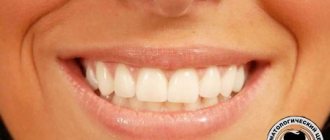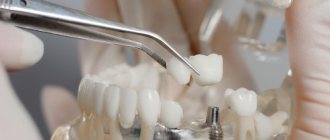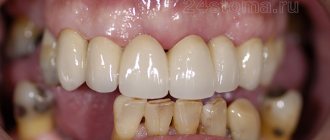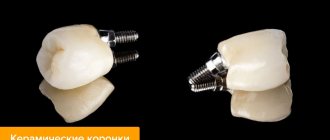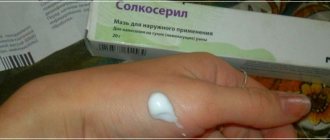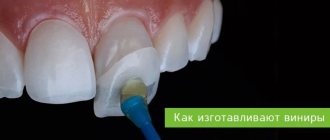A crown is the name in dentistry for a prosthesis that is placed on a tooth, on an implanted implant, or included in the structure of a dental bridge. With the help of dental crowns, you can restore severely damaged or lost teeth, the restoration of which must be carried out urgently and for this you must contact a dentist.
How the crown will be installed, whether it hurts to put a crown on a tooth - we will answer all these questions in detail in our article.
When is it necessary to put a crown on a tooth: indications for restoring teeth with a crown
The need to place a crown on a tooth may arise in the following situations:
- The tooth is severely damaged by caries. If the natural crown of a tooth is damaged by more than 50% by caries, then it would be more correct to put a crown on the tooth rather than restore it with a filling. Large fillings do not withstand the chewing load well and may fall out or break, and the tooth may break along with the filling. If the root of the tooth is damaged, then it will have to be removed. By placing a crown on a decayed tooth, you have the opportunity to save it;
- The tooth is destroyed as a result of trauma. If the roots of a tooth were not affected by injury, it is possible to restore the tooth - it will be enough to put a crown on it;
- You can also put a crown on a tooth for aesthetic restoration: for example, if a tooth is chipped or its enamel has changed color, becoming gray or yellow, and this defect cannot be eliminated by classic whitening.
Doctors recommend placing temporary crowns to preserve teeth for patients with periodontitis. In this case, crowns prevent teeth from becoming loose and falling out.
In your case, do you need to put a crown on your tooth or is it possible to use another restoration method? The doctors of our dental clinic in Moscow, “Firadent,” can help you find the answer to this question. To make an appointment with our specialists, you just need to dial our dental clinic’s phone number!
Frequently asked questions to the doctor
Implant rejection
I heard that implants are rejected in most cases, is this true?
In fact, such a situation occurs. In rare cases, the body may not accept the implant. But still, as practice shows, in 95% of cases such surgical intervention is successful, and the person receives beautiful and straight teeth. Don’t be afraid, you just need to choose a good specialist and clinic.
Prosthetics
I would like to know why prosthetics are necessary?
Prosthetics are primarily necessary to ensure that chewing function is restored. First of all, this includes gastroenterological indications, because if the food is chopped poorly, the stomach will begin to work incorrectly.
I need to put a crown on a tooth: is the treatment painful?
Statistics show that most people, knowing that they need to put a crown on a tooth, still postpone their treatment for fear of visiting the dentist and the pain that supposedly cannot be avoided with dental prosthetics. Does it really hurt to put a crown on a tooth? Let's look at this issue together.
So is it painful to put a crown on a tooth or not? The most painful stage in the process of installing a crown on a tooth will be the preparation, during which the teeth are treated for caries, depulped (if necessary), and also ground down to the thickness of the future crown. All these procedures are not performed without anesthesia, as they can cause quite severe pain to the person.
Before you begin to treat and prepare the tooth for placing a crown on it, the doctor will definitely perform an anesthesia procedure using a local anesthetic. The type and amount of the drug are selected individually for each patient. The use of anesthesia makes the process of preparing the tooth for crown installation painless.
If the patient experiences a literally panicky fear of dentists, in our dental clinic “Firadent” he may be offered dental treatment in his sleep[/anchor], under sedation. Sedation should not be confused with general anesthesia; it is a light medicated sleep in which the patient will remain during treatment. Sedation allows you to relieve the patient not only from pain when preparing teeth for prosthetics, but also from psychological discomfort and stress! Moreover, after sedation there are no negative side effects, which are not uncommon after general anesthesia.
You can read all the details on dental treatment during sleep in a separate article on our website, which is devoted to sedation, or find out during a consultation with the doctors of our clinic - “Firadent”.
Features of physiological prosthetics
To make the most comfortable dentures, you cannot follow standard solutions. Each patient is individual, therefore, at Dial-Dent, a dental prosthesis is formed taking into account all the characteristics of a particular patient. To do this, you may need to come to the fitting again or conduct a photo shoot, but all these actions are aimed at obtaining a high-quality result. A properly made denture can completely change your appearance, giving you confidence, youth, and beauty. The convenience of using high-quality complete dentures also adds positive emotions and allows you to enjoy life to the fullest.
Family Dental specialists carefully approach the problems of each patient, finding a solution to suit every taste, budget and requirement. Make an appointment with an orthopedic dentist at Dial-Dent and restore your lost teeth, bringing back all the colors of your life.
Initial examination and diagnosis
The decision that a crown needs to be placed on a tooth is made by an orthopedic dentist after examining the patient’s oral cavity and teeth, as well as performing a number of diagnostic measures. Based on the data obtained, the orthopedist will develop a treatment plan, which may include not only the installation procedure itself, but also a number of additional measures:
- Professional oral hygiene, which allows you to clean your teeth from plaque and tartar;
- Removal of severely damaged teeth that cannot be properly treated and restored with a filling;
- Treatment of caries and any other diseases of the teeth and gums diagnosed during examination;
- Tooth removal, treatment and filling of canals.
Note that depulping a tooth before placing a crown on it is not always done. The depulpation procedure involves removing the dental nerve, after which the tooth becomes more fragile and vulnerable to external factors. If a tooth has more than one root and is in good condition, doctors prefer not to remove the dental nerve and put a crown on a living tooth.
When drawing up a treatment plan, the question of what kind of crown will be placed on the tooth is also decided. Modern dental crowns are made from different materials and there is always the opportunity to choose the version of the prosthesis that will most suit the patient in terms of aesthetics, price and durability.
The drawn up treatment plan is agreed with the patient and after agreement the treatment process begins. The first step is to prepare the tooth for the installation of a crown.
Survey
Diagnostics helps to accurately assess the condition of teeth, gums, and facial bones and determine the optimal method of treating edentulism. To do this, the dentist:
- Interviews the patient and listens to complaints.
- Examines all organs of the oral cavity - teeth, gums, tongue.
- Prescribes radiography or CT (computed tomography).
The images help determine whether the teeth adjacent to the defect are suitable for use as supports. Sometimes, after radiography, it also turns out that adjacent units are not suitable for adjacent implants or bridges.
Preparing to install a dental crown
Preparing for a dental crown may include the following procedures:
- Professional teeth cleaning. Removing tartar and plaque from the surfaces of teeth will help you accurately select the color of the future crown, as well as identify primary caries and other diseases that are important to cure before placing a crown on the tooth.
- Treatment of caries, pulpitis, periodontitis, and gum inflammation. You can’t put a crown on sick teeth!
- Treatment of the tooth on which a crown will be placed. During this process, the doctor will drill out the tooth and remove all tissue affected by caries. If necessary, tooth depulpation is carried out, as well as treatment and filling of dental canals.
IMPORTANT: Dental canal treatment must be of high quality! If during the treatment of the canals the doctor makes a mistake, does not remove all the tissues affected by inflammation, or fills the canals incorrectly, the tooth may begin to hurt already under the crown, and then it will have to be removed and treated again! In our dental clinic “Firadent” in Moscow, treatment of tooth canals is carried out under a microscope with an optical device, which allows the doctor not to act at random, but to accurately see the length and internal space of the dental canals, and therefore carry out the procedure with impeccable quality.
After filling the canals, the tooth is restored with a filling and the next stage in prosthetics begins - turning the tooth under a crown.
Installation of prostheses
When the crowns or dental bridges are ready, the final stage of prosthetics will begin. Installation of structures is carried out in accordance with the chosen method. If removable dentures are performed, the doctor shows the patient how to properly put on and remove the structure from the mouth. A specialist fixes permanent crowns and bridges in such a way that they are securely held on the supporting elements. There is no need to remove such dentures yourself; they remain in the oral cavity permanently.
Before installation, fittings are carried out to show whether adjustment (correction) of the structure is required. After the patient approves the prosthesis, the dentist performs its final fixation.
Grinding a tooth for a crown
Before placing a crown on a tooth, the tooth must be ground to the thickness of the future prosthesis. This procedure in professional dentistry is called “preparation”. The enamel of the tooth is ground down with a drill and during the treatment the doctor will give the tooth a shape that will allow the crown to be placed firmly and tightly.
IMPORTANT: Grinding of live teeth can be quite painful, so local anesthesia must be administered before performing this procedure. If the tooth was depulped before grinding, local anesthesia may not be used, the procedure will not cause pain.
When preparing teeth, a layer of tissue is removed from the tooth before placing a crown. The thickness of the layer will depend on how thick the crown will be. A minimal layer of tissue is removed from the teeth for cast crowns; a significant layer of tissue must be removed from the tooth if it is decided to install ceramic or metal-ceramic crowns. On average, during the grinding process, about 2.5 mm of tissue is removed from a tooth on each side.
As a result of tooth preparation, a core base (stump) is obtained, on which the doctor will place a crown.
Removable dentures - what are they?
Removable dentures are devices that partially or completely replace lost teeth. A distinctive feature of removable structures is the ability for the patient to remove and put them on independently. This feature unites all types of removable dentures with a significant variety of types and models.
Despite the advantages of modern fixed prosthetics, removable dentures also have their advantages:
- relatively low price;
- ease of manufacture and operation of the orthopedist;
- the ability to choose a manufacturing material that is suitable in price and quality;
- the ability to restore any defect in the dentition;
- lightness of the prosthesis, the ability to choose the desired shade of material;
- no need to prepare healthy teeth for prosthetics;
- the ability to repair a damaged model in a dental laboratory;
- ease of care.
Removable dentures solve the problem of restoring the aesthetic and chewing function of teeth when they are lost and it is impossible to establish a fixed model, and therefore increase the quality of human life.
Making crowns
Crowns are made from an impression that is taken from the prepared teeth. To obtain this impression, the orthodontist will use a special plastic mass. Based on the impression taken, the laboratory will first make a plaster model of the prosthesis, and then a crown, which will be placed on the tooth.
Modern dental crowns are made from different materials: metal, ceramic, metal-ceramic and zirconium. The timing of the production of the prosthesis will depend on what kind of crown it is decided to place on the tooth. Crowns made of ceramics and metal-ceramics take the longest to produce. So that a person does not have to walk without a tooth during the entire time of making the crowns, a temporary plastic prosthesis is put on the tooth.
IMPORTANT: Temporary plastic crowns help hide a defect in the dentition; a person will not have to be embarrassed by the absence of a tooth and experience stress for this reason. Also, temporary dentures help protect a ground and therefore weakened tooth from the negative effects of environmental factors and bacteria.
Neuromuscular occlusion
The position of the lower jaw in space affects posture and the condition of the skull bones. Any misalignment of the lower jaw, caused by multiple missing teeth or an incorrectly designed bite during the fabrication of complete dentures, causes the cervical vertebrae to become misaligned as they attempt to balance the situation. The entire spine shifts according to these changes to achieve balance, which disrupts normal posture. On the other hand, tensions from incorrectly and asymmetrically working masticatory muscles are transmitted through the teeth to the bones of the skull, and as a result, neurological reactions can occur, expressed as chronic headaches, especially in the temples and in the suboccipital region, dizziness, clicking in the temporomandibular joints, neck pain, blurred vision and hearing, numbness in the fingertips.
When determining the position of the lower jaw, a state of neuromuscular bite is achieved, and not the usual one, for which the muscles are affected by electrical impulses. Electrical exposure time is about 45 minutes. The muscles relax and the jaw moves from its usual position to a physiological one. Then a graph of the movement of the lower jaw and muscle work is taken (computed myography).
The found correct position of the lower jaw is used in the design of dentures. Osteopathic correction helps compensate for muscle imbalance caused by the new unusual position of the lower jaw. Neuromuscular occlusion maintains the health of the entire body and ensures the longevity of dentures.
If we take into account the natural interaction of the anatomical parts and the tension of the neuromuscular fibers, as well as the natural position of the former dentition, the prosthesis will stay more securely in the mouth in the position of non-closing teeth and function better without causing inconvenience and unpleasant sensations.
Try-on, temporary and permanent fixation of the crown
Before placing a crown on a tooth, it must be tried on. For this purpose, the patient is invited to the clinic. During the fitting, the accuracy of the crown's manufacturing and the tightness of its fit on the stump base are assessed. If the fitting does not reveal manufacturing inaccuracies, the patient does not feel discomfort and is satisfied with the aesthetics of the finished product - a temporary fixation of the crown is performed on the tooth.
What is temporary fixation? This is a kind of “test drive” of the crown. With a crown placed on a temporary basis, the patient will walk for a certain period of time (usually up to 4 weeks). If during this time no defects or inaccuracies are identified in the manufacture of the crowns, the patient comes to the clinic and the crown is placed and fixed with permanent dental cement.
At this point, the crown installation process can be considered complete.
Mini-implantation and overdentures
Mini-implants are designed to improve the fixation of removable nylon dentures on the patient's jaw. Such dentures are sometimes called overlay dentures. This method refers to conditionally removable prosthetic methods.
Mini-implants serve as support for overdentures, and fixation (clicking) is carried out using silicone matrices. The simplest and most convenient is the spherical (push-button) fastening, which requires the implantation of at least 2-4 implants. The greater the number of supports, the more reliable the fixation will be, the less likelihood of bone tissue atrophy, but the higher the overall cost of prosthetics.
The main advantages of mini implantation are reliable fixation of the prosthesis, the ability to install implants without incisions, the ability to install a covering prosthesis immediately after, no need for bone grafting, and the cost is lower when compared with classical implantation.
The main disadvantages are that the plastic base cannot cope with loads like real teeth, the load is still not distributed evenly enough, and fixed prosthetics are not feasible.
How to place a crown on an implant?
A crown can be placed not only on a tooth, but also on an implant. This allows you to restore lost teeth without grinding down healthy units in the rows. Crowns on implants are durable, aesthetic, and visually indistinguishable from natural teeth.
Before placing a crown on an implant, an artificial root implantation procedure is performed. As soon as the implant takes root, an abutment is placed on it, and then a crown. Putting a crown on an implant will be more expensive than conventional prosthetics, but the price of the service is fully compensated by the impeccable aesthetics and long service life of both the implant and the crown.
How to insert a tooth if there is no root?
If you have had a tooth removed, you can insert it using implantation, and this can be done immediately after the extraction procedure - using the method of one-step implantation. With this method of tooth restoration, implants are implanted directly into the socket of the extracted tooth and then a temporary prosthesis is placed on them. Simultaneous implantation will allow you to insert a tooth and not walk with an unpleasant dentition defect. The doctor will install a permanent crown on the implant abutment after it has fused with the bone - this usually takes 3-4 months.
Implantation is recognized as the most reliable and durable way to restore extracted and lost teeth, but it is not always possible to replace teeth with it - there is a fairly wide range of contraindications for this surgical operation.
Crown service life
Patients who plan to get a crown are often interested in its useful lifespan. The service life of a crown placed on a tooth will depend on a number of factors:
- Crown material and technology;
- The patient’s compliance with all doctor’s recommendations for crown care;
- Quality of preparation of teeth for prosthetics.
The last factor is of fundamental importance: if mistakes are made during the preparation and manufacturing of the crown, the crown will not last long, and undesirable complications may arise, due to which the crown will have to be removed and re-installed on the tooth. For these reasons, you need to very carefully choose the clinic where you plan to treat and restore your teeth! Remember that the worst type of saving is saving on your own health!
The crown must be placed in a well-equipped dental clinic, staffed by experienced orthopedic doctors and dental technicians. The clinic must use the most modern technologies for diagnostics, treatment and dental prosthetics; only this approach to the choice of dentistry guarantees high quality treatment!
Dental prosthetic options
The main factors that determine the choice of dental prosthetics (if we do not take into account the financial factor for now) are the purpose of the procedure (esthetics or chewing function), as well as the number and location of teeth to be restored. To improve the appearance of healthy (usually front) teeth that have external defects (darkening, chips, cracks, misalignment or size), veneers (special ceramic onlays) or crowns are used.
Crowns are also used to preserve weakened or noticeably damaged (for example, broken or worn down) teeth. They are a kind of caps that are put on a ground tooth. They are made of metal (this outdated technology is still used in some clinics) or modern materials: plastic (temporary crowns), metal-ceramics and ceramics (porcelain, zirconium dioxide, etc.). Both veneers and crowns are non-removable prostheses.
In the absence of 1-2 teeth, either a bridge prosthesis is used - a metal structure (bridge) is attached to the adjacent teeth, used as a support, onto which crowns are fixed, completely reproducing the appearance and function of the lost teeth. Or it will be a prosthesis (crown or bridge) supported by implants.
The advantages of prosthetics on implants are the absence of the need to grind down adjacent teeth, the absence of additional load on them, and the transfer of chewing load to the jawbone (through the metal root), which prevents its atrophy.
The disadvantage is the rather high cost and the need to undergo surgery (implantation of an artificial metal root). If several teeth are missing in a row and it is impossible (or unwilling) to perform implantation, a removable denture is made. For example, clasp (design on a durable metal plate).
In case of complete absence of teeth (edentia), a prosthesis made of acrylic plastic is made. A distinctive feature of removable dentures (both clasp and acrylic) is the ability for the patient to remove and install them independently. The structure is fixed in the oral cavity with special clasps or micro-locks (for clasp ones), or by suction to the gum (for acrylic ones).
Fixed bridge
Restoring teeth with the installation of dentures that the patient cannot remove on their own is called permanent dental prosthetics. These include veneers, crowns (metal-ceramic or ceramic), dental inlays and bridges. Prosthetics on implants is also classified as a non-removable type.
But in some cases, prostheses are placed on implants, which are called conditionally removable. This is due to the fact that you cannot remove them yourself, but a dentist can easily dismantle them by unscrewing the fastening screws - for example, for professional cleaning, repair or replacement. The implants themselves will remain in place.
Crowns
Long gone are the days when crowns were made only of steel and gold. Today, many modern materials are used for dental prosthetics, which are not inferior in strength or aesthetics to natural teeth. The choice of a specific crown material is dictated by both the method of procedure and the financial capabilities of the patient.
Let's look at the advantages and disadvantages of the main types of dental crowns for prosthetics:
- metal ceramics – lining a metal frame with a ceramic composition,
- ceramics – made from porcelain, zirconium dioxide or glass ceramics.
Metal crowns can (and are sometimes) used today. They have undoubted advantages: high strength, teeth need to be ground less for them. But it is necessary to choose solid crowns made of high-quality metal and use them only for the farthest chewing teeth, where they will not be visible.
Ceramic crowns made from porcelain are cheaper, but are the least durable; glass ceramics are the most durable and beautiful, but the most expensive. Zirconium dioxide is the golden mean. Ceramic crowns are not used for prosthetics of chewing teeth due to their insufficient strength for this function. Their area of application is the front teeth, where aesthetics are very important and the chewing function is secondary.
Metal ceramics
Metal-ceramic crowns are excellent for restoring chewing teeth. They can also be used for prosthetics of front teeth, but in this case it is necessary to check their compatibility with existing natural teeth.
Metal-ceramic crowns are opaque (otherwise the metal base will show through the coating), so if your front teeth have a high coefficient of transparency, then teeth with crowns will differ from natural ones. If, nevertheless, a decision is made to prosthetize the front teeth with metal-ceramics, then it is better to choose crowns with shoulder mass, since they do not cause cyanosis of the gums, unlike conventional ones.
Complete dental prosthetics
In case of complete absence of teeth, it is necessary to make a removable or fixed denture. The removable option involves making an artificial jaw from polymer materials (acrylic, nylon, etc.). The structure is fixed in the oral cavity by suction to the gums, just like a suction cup is attached to glass.
The production of such a prosthesis is quite fast, their prices are moderate, and installation does not involve any serious interventions. However, they also have serious disadvantages. The prosthesis must fit perfectly. If it does not fit perfectly, or if during use the shape of the soft tissues has changed slightly (and it will change, because the design does not transfer the chewing load to the jaw bone, which is why bone atrophy will continue), then the prosthesis will not hold well and keep falling out.
The removable version is very massive, extends far beyond the dentition, rests on soft tissue and in some patients causes a gag reflex. Getting used to such a design is a very slow matter (up to 1 month), and some people do not manage to get used to it at all. Hard dentures often rub the gums during chewing, while soft dentures distribute the load unevenly, causing discomfort. The service life of removable polymer dentures is 5-7 years in the most favorable case.
An alternative is complete dental prosthetics using fixed (or conditionally removable) structures supported by implants. The most commonly used are 3 methods: basal implantation, prosthetics on 4 implants (All-on-4) or prosthetics on 6 implants (All-on-6). Basal implantation means the placement of 8-12 elongated implants into the dense layers of the jaw bone.
The advantage of this method is the absence of the need to do bone augmentation, the ability to do without cutting the gums and drilling the bone, the initial strong fastening of the implants, which allows you to immediately install a prosthesis on them. On the other hand, placing a large number of implants makes the procedure more complex, and the lack of large-scale studies of the behavior of implants over many years does not allow for firm guarantees, unlike other implantation methods, which provide a lifetime guarantee on the implants.
Prosthetics on 4 implants
More predictable and well-researched is the method of dental prosthetics on 4 implants. It also allows you to receive a ready-made fixed prosthesis within 3 days after surgery. But the peculiarity of this type is that this design will be temporary and will have to be replaced with a permanent one in a few months (from 5 to 24 months, depending on individual characteristics).
The main difference between the different types of temporary structures is the presence of a metal frame. A temporary prosthesis with a frame is optimal - it is strong enough to last 2-3 years before being replaced with a permanent one. But embedding a metal frame with a screw connection with implants into an acrylic base is a very labor-intensive procedure, due to which the cost will be noticeably more expensive.
An acrylic temporary denture without a metal frame will be cheaper, but it has noticeably less strength, which is why its service life does not exceed 5 months, and even during this time, structural failures are common, especially in men with large and well-developed jaws. A temporary (adaptation) prosthesis must be properly maintained - once every six months (and sometimes more often) it requires professional cleaning by a dentist, and once a year - replacement of the fixing screws.
There are many types of permanent structures for all-on-four prosthetics, so the desired option is selected individually in each clinic, according not only to the specific clinical situation (for example, the amount of space for dentures, determined by the degree of atrophy of the jaw bone), but also to the capabilities of the clinic and the patient.
The highest quality are titanium-polymer prostheses from Nobel Biocare, however, they are characterized by high cost and require a large amount of space for prosthetics, i.e. Patients with a slight degree of bone atrophy will not be able to install them.
Another option is bridge-like structures made of zirconium dioxide or metal ceramics. Their frame can be made of titanium or zirconium dioxide, and in some cases of nickel-chromium alloy, but the beam must be milled. The use of cast structures reduces the strength and accuracy of fit, which can lead to problems in the future.
Prosthetics on 6 implants
The previous method is not suitable for all patients. In large men, young men (under 55 years of age), those who prefer solid foods (meat, fresh vegetables), and those with very soft bones, implants located on the side will experience increased stress, which will inevitably lead to their loosening, resorption of bone tissue around the implants and breakage (or loss) of the prosthesis after a few years.
For such patients, dentures with 6 implants are always recommended as a more reliable and suitable option to avoid overloading the lateral implants. The operation can also be performed using surgical guides or the traditional method with incisions. Loading of installed implants with a prosthesis can be performed within 2-3 days after surgery.
To install a prosthesis, it is better to use branded Multi-unit abutments, since to remove the prosthesis in the future (if it is necessary to clean or replace a temporary one with a permanent one), Multi-unit abutments, unlike standard ones, allow you to remove only the prosthesis, and other abutments will have to be removed along with it , injuring the gums, which creates a risk of infection and the development of inflammation of the tissue around the implants, and this, in turn, can lead to rejection.
A temporary (adaptive) prosthesis is usually included in the cost of prosthetics using the “all on 6” system, just like the “all on 4” system. And the permanent one will have to pay extra. Temporary, as already discussed above, it is better to choose one with a metal frame, especially for men, even though it will be more expensive. It is better to choose a permanent one based on milled titanium or zirconium beams, or, in extreme cases, cobalt-chrome beams. Cast beams are significantly less strong and their fit is less precise.
It should be noted that prosthetics using the “all on 4” and “all on 6” systems always imply implantation with immediate loading, i.e. the prosthesis (temporary) is placed immediately - within 3 days after the operation. Some clinics offer installation using a delayed loading protocol - i.e. after 4-6 months, during which you will have to use a conventional removable acrylic denture. But this is not an “all on 6” (or “all on 4”) technique, but a conventional two-stage implantation.
Partial prosthetics
In the absence of part of the dentition, partial dental prosthetics is performed using a bridge or clasp prosthesis. Those. In this case, structures can be removable or non-removable. To install a fixed bridge, healthy abutment teeth must be preserved at the edges of the edentulous area. The bridge is a metal arch on which crowns are located, simulating missing teeth.
Along the edges there is a system of attachment to the supporting teeth. They are ground down and crowns are also put on them. In the absence of supporting ones, it is possible to install a bridge prosthesis on implants. A removable bridge with partial absence of teeth also implies that the structure will be attached to the supporting teeth. These can be dentures made of acrylic or nylon, or clasp ones.
Partial plastic dentures have clasps with which they are attached to the supporting teeth. Because of this, this type of denture is not used in cases where the supporting ones are located in the smile area, because the clasps will be visible. In addition, such dentures can cause discomfort and pain when chewing. It will be more convenient to install clasp frames.
Clasp prosthetics
A characteristic design feature of clasp dentures is a special metal arch (clasp). In the upper jaw structure it passes through the palate, and in the lower jaw it passes behind the front teeth, adjacent to the alveolar ridge of the jaw bone. The metal base is made of titanium, cobalt-chrome alloy, or precious metals.
Its strength makes it possible to reduce the total weight of the structure and the thickness of the plastic base, which has a positive effect on the ease of use of the prosthesis. For clasp dentures, the supporting teeth located on both sides of the jaw must be preserved.
This is one of the most optimal options for a removable bridge, because:
- clasp dentures effectively restore chewing function,
- firmly fixed on the jaw,
- do not impair diction,
- have a long service life.
To fix the clasp structure, various mechanisms are used - clasps (wire loops), micro-locks and telescopic crowns. The best, most reliable and aesthetically impeccable are clasp dentures with micro-locks and especially telescopic crowns.
They have one drawback - they are very difficult to manufacture and require highly qualified orthopedists and dental technicians, and therefore have a higher cost. But they better transfer the chewing load to the supporting teeth and practically do not cause their destruction, which, for example, occurs with the clasp system on clasps.
Prosthetics of lower teeth
The procedure has a number of features. First of all, aesthetic requirements for the lower teeth are less stringent, since the lower teeth are not as visible as the upper teeth. Also, the lower teeth are subject to a much greater chewing load, which places greater demands on the strength of the prosthesis and the reliability of its fixation.
And in addition, the anatomical features of the lower jaw (absence of a hard palate, frenulum of the tongue, etc.) make dentures difficult, making the task of achieving a strong fixation of the prosthesis much more difficult. As a result, prosthetics for the lower teeth turns out to be somewhat more complex, and the dentures may have a slightly different design. However, the same technologies apply to the lower teeth.
To restore healthy teeth with partial external damage, veneers and crowns are used here, and if 1-4 teeth are completely lost, a permanent bridge can be installed, supported by ground adjacent teeth. Or a removable plate made of acrylic or nylon, with clasps made of metal wire or polymer material.
If there are supporting teeth on both sides of the jaw, it is possible to install a clasp prosthesis, the design of which will differ from that used for prosthetics of the upper teeth in the shape and location of the arch. In case of complete edentia (absence of teeth) in the lower jaw, the dentition is restored using a removable full plate bridge, or a conditionally removable one on implants.
The latter option has a secure fit and impeccable functionality. In the lower jaw, implantation is easier, and the higher bone density often makes it possible to avoid lengthy and expensive bone augmentation surgery. Implants completely imitate natural teeth, including transferring the chewing load to the jawbone, which slows down its atrophy and allows you to use the prosthesis without correction or replacement for a longer time.
Prosthetics of anterior teeth
Front teeth always play an important role in a person’s appearance, so their restoration is almost always an urgent and pressing task that is important to solve as quickly as possible. As a result, prosthetics of the front teeth is associated not only with recreating the shape and appearance of the tooth itself, but also with the aesthetics of a smooth and beautiful gingival margin.
You can correct aesthetics (darkening, abrasion and small chips, gaps between teeth) with the help of veneers or lumineers, and you can restore severely damaged teeth by installing crowns on them. When one or more front teeth are lost, the problem of prosthetics is best and most effectively solved by installing implants.
The chewing load on them in this area is minimal, and quick prosthetics after tooth loss eliminates bone resorption and makes bone grafting unnecessary. When implanting with immediate loading, the patient receives a fully functional structure immediately (however, several months later, after the implant has completely engrafted, the prosthesis will have to be replaced with a permanent one).
In the case of a two-stage implantation protocol, while the implant is healing, the hole is closed with a temporary butterfly prosthesis, fixed with polymer clasps to the adjacent teeth. And after a few months, a gum former is placed, and after another 3-4 weeks - a permanent option. If implantation is not possible, one of the best options would be to install a clasp prosthesis.
Urgent prosthetics
If it is necessary to restore the integrity of the dentition as soon as possible, the patient is offered emergency dental prosthetics, which usually involves installation within one day. These can be temporary removable structures made of acrylic or nylon, other types of plastic, or non-removable ones - for example, temporary crowns. This type of dental prosthetics is used during tooth extraction and during the restoration process.
Another option is express implantation. Installation of a special implant with a bioactive surface can be non-surgical, or rather performed without an incision in the gum. A temporary crown or prosthesis can be immediately installed on such implants.
A characteristic feature of urgent prosthetics is that it is always a temporary structure that must be replaced with a permanent one after some time. Such prostheses are not very durable and have a limited service life.
Turnkey prosthetics
When calculating the cost of dental prosthetics, it is important to take into account all the nuances and costs at all stages. Clinics often try to show a lower cost of the procedure, without including in the price list the cost of some materials or procedures, which the patient will nevertheless have to pay.
That is why such an item as turnkey prosthetics arose. This means that by paying the specified amount, the patient will receive a fully functional prosthesis and will not have to pay anything else for this. However, it is necessary to take into account that in some cases the turnkey cost includes only the cost of manufacturing and installing a temporary prosthesis, which will later have to be replaced with a permanent one.
The cost of a permanent structure and its installation is not included in the price of the turnkey procedure, primarily because the permanent structure is installed several months (6 or more), or even 2-3 years after temporary dental prosthetics. And it is simply impossible to calculate in advance the cost of permanent dentures for months and years in advance, without knowing what type of prosthesis will be installed and how prices will change.
How much does it cost to put a crown on a tooth?
How much does it cost to put a crown on a tooth? It is difficult to give a definite and precise answer to this question, because the cost of installing a crown may include various additional but necessary procedures. For example, professional teeth cleaning, treatment of caries or pulpitis, treatment and filling of canals.
The cost of installing a crown will be influenced by both the material and the production technology of the prosthesis. The most expensive options are ceramic and zirconium crowns produced using CAD/CAM technology. But such crowns fully pay for their cost due to their high strength, reliability and aesthetics.
Also, the cost of installing a crown will depend on how it will be placed - on an abutment tooth or on an implant.
The best way to find out how much it costs to put a crown on a tooth is to come to an appointment with orthopedic doctors at our dental clinic in Moscow - “Firadent”. Experienced specialists of our dentistry will conduct an examination and diagnosis and draw up a treatment plan, which will indicate the exact price of the service.
Artificial gum method
With this method, a crown with an artificial gum is installed, which imitates the real one in color and shape. The gingival margin here is always clearly defined, the height of the teeth is anatomically correct, and the smile is attractive. The edge of the gums and papillae (small triangles between the teeth) are modeled from a special material, so the structure looks natural. Patient photographs clearly demonstrate the attractive aesthetics of such restoration.
Which method is better
There is no treatment that suits everyone, so the dentist decides which method to use based on the clinical picture and the data collected. Tissue augmentation may be impossible for a number of reasons, or artificial gum cannot be used for various reasons. Large clinics will consider both options because they have the basis for using either option. In small dentistry, the doctor may lack experience in tissue transplantation, or the technicians may not have the material to make artificial gum on the prosthesis.

